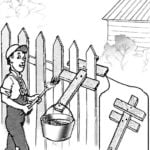 In recent years, and became noticeable interference in a household outlet, requiring protection home electronic equipment TVs, home audio, computers. These impairments lead to “tearing” of the image on the screens, heard the clicks and POPs from the speakers, “sboyat” digital devices. It is especially annoying when this happens while recording any programs.
In recent years, and became noticeable interference in a household outlet, requiring protection home electronic equipment TVs, home audio, computers. These impairments lead to “tearing” of the image on the screens, heard the clicks and POPs from the speakers, “sboyat” digital devices. It is especially annoying when this happens while recording any programs.
In my opinion, there are three causes of this interference
1. Increasing the power of the household appliance, for example, when a standard iron power was 600 W Now, as a rule, the power of these devices rolled over a kilowatt more Powerful than the steel electric kettles, vacuum cleaners, drills, etc There are many new electronic devices (e.g. microwave ovens, ultrasonic humidifiers, and so forth), creating high frequency and pulse interference in the network, at the time of on-off and during operation.
2. Now, despite the apparent richness of choice, virtually no household equipment normal middle class. Very indicative in this respect the products of China, enterprises which produce goods for Western countries (with the mark for EU) and other countries (unmarked). Now we have to choose between the extremes of super-expensive machines with programmable equalizers reverbs and such complexity that it is not always appropriate, even in professional equipment, or to take cheap with only one volume control. Such equipment circuit protection from surges primitive (can’t help noting that this trend is clearly visible in photography and household appliances, accurately describes the world imposed “democracy” and the direction of evolution).
3. The collapse and enfeeblement of the power industry also do not contribute to the quality of power supply. So, in our city in recent years are clearly visible even by the lamp noise, sometimes like a flash of lightning. Effective protection from these interferences is simple — apply a low-pass filter. Installed in this capacity and inductance are too small to significantly weaken the industrial frequency, but delayed that sharply stands out from the smooth sine wave of 50 Hz. Many are forced to buy very expensive extenders and splitters such devices. Meanwhile, to get a filter well-designed and proven design is now possible for practically nothing. Currently thrown away many domestic TV 3rd generation power supply circuit include TFG — cost power supply filter. Conducted experiments have shown a marked improvement in the quality of image and sound on a variety of devices connected through it. It is important that the total power load does not exceed 120 watts. The elements of R1 (a and b), R2 includes the circuit of degaussing of a CRT. When you turn off the coil degaussing they are not involved in the operation of the device and, say, for the sake of compactness of the filter, together with the connector x2 can be disassembled. Resistor R3 can also be circumvented. It is designed to limit the inrush current when you turn on the TV. In industrial apparatus, this problem is probably solved anyway. Although decide for yourself what is more important — maximum suppression or minimal loss of voltage. Dealing with such a network, the filter, of course, must be equipped with fuses. The holders can be borrowed from the same TV along with the power cord. So much solder is not necessary. You can leave your regular power switch, if necessary Although it’s better to replace it with some others — unfortunately, used in these TVs switches PKN-41 — one of the most unreliable devices of this appointment.

A circuit diagram of a low frequency protective filter for inclusion in a domestic mains voltage of 220V household electronic appliances
If necessary, a filter can be provided to the indicator of inclusion. Modern led heterostructures academician Alferov extremely effective — provide a fair amount of brightness at a current of only 1 mA and can be any color Diode VD 1 protects the led from high reverse voltage. It is possible to use two LEDs, included counter-parallel. Or instead of the diodes — almost any “neonki”. The indicator the more desirable, since it provides the discharge of the filter capacitors if it has been disconnected from the load before the network thereby preventing the danger of destruction of their charge.
If you are equipped with grounding and outlets with earthing contact, and in the filter it is desirable to use a three wire cord and appropriate plugs and sockets. The ground circuit connects to the connector X4 as provided for in the regular mode. Schematic diagram of the filter, presented here, performs most of its development (different TFG may differ from each other by the component values and layout).
Structurally, the device can be constructed in a separate building with one or two outlets for connecting loads or embedded inside the device, most suffering from interference.
A. LISOV, Ivanovo



